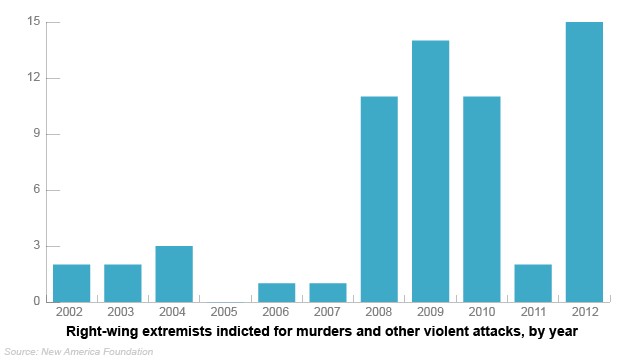Apr 05, 2013
Growing threat of extreme right-wing violence, CNN.com
Growing threat of extreme right-wing violence
By Peter Bergen, CNN National Security Analyst, and Jennifer Rowland, Special to CNN
updated 9:02 PM EDT, Thu April 4, 2013
STORY HIGHLIGHTS
- Authors: Last five years have seen more indicted in extremist violence
- They say the threats have grown from domestic sources, particularly the right wing
- Jihadist groups no longer make up the greater threat, they say
- Authors: It's about time for politicians to notice the shifting threat

Peter Bergen
Clements was the latest victim of increasingly active violent right-wing extremists. While American politicians and the U.S. public continue to focus on the threat from jihadist extremists, there seems to be too little awareness that this domestic form of political violence is a growing problem at home. From 2002 to 2007, only nine right-wing extremists were indicted for their roles in politically motivated murders and other types of ideologically motivated violent assaults. But between 2008 and 2012, the number mushroomed to 53, according to data collected by the New America Foundation. (Click on chart on the left for the data.)

Become a fan of CNNOpinion
Stay up to date on the latest opinion, analysis and conversations through social media. Join us at Facebook/CNNOpinion and follow us @CNNOpinion on Twitter. We welcome your ideas and comments. But it would also be much different if city workers hadn't spotted a suspicious backpack left on the route of a Martin Luther King Jr. parade in Spokane, Washington, in January 2011, in which white supremacist Kevin Harpham had hidden a bomb packed with fishing weights coated in rat poison. Or if police hadn't discovered a napalm bomb and several other live, wired explosives in the suburban Cleveland home of right-wing extremist Matthew Fairfield in April 2010. And of all the people indicted on terrorism charges in the United States since 9/11, no jihadist suspect has ever acquired or attempted to acquire chemical, biological or radiological weapons, while at least 11 right- and left-wing terrorists either obtained such materials or made serious attempts to do so. In 2003, federal agents discovered "nearly two pounds of a cyanide compound and other chemicals that could create enough poisonous gas to kill everyone inside a space as large as a big-chain bookstore or a small-town civic center" at the home of Judith Bruey and her husband, William Krar, according to an Associated Press report. Alongside the arsenal of chemical weapons were about 60 pipe bombs, several machine guns, remote-controlled bombs disguised as briefcases, and anti-Semitic, anti-black, and anti-government literature, the report said. Although the feds had been tracking Bruey and Krar in the mid-90s, their case fell through the cracks when the events of 9/11 turned law enforcement's attention to jihadist terrorism. The couple was only found out when Krar tried to mail a package of counterfeit birth certificates to an anti-government militia member in New Jersey, but got the address wrong. That mistake resulted in a tip to local police. A report from the Combating Terrorism Center at West Point released in January found that, "In the last few years, and especially since 2007, there has been a dramatic rise in the number of attacks and violent plots originating from people and groups who self-identify with the far-right of American politics." In a report that was much criticized at the time, the Department of Homeland Security predicted in 2009 that the nation's election the previous year of its first black president, along with a severe economic downturn that created disenchantment with the government among poorer populations, had the potential to radicalize greater numbers of right-wing terrorists. The same report warned that increasing numbers of returning military veterans as the wars in Iraq and Afghanistan wind down provided those on the far right with a vulnerable population to target for radicalization. The New America Foundation data shows that about 20% of the right-wing extremists indicted since 9/11 had spent time in the military. The New America data supports the Department of Homeland Security's assessment of the growing threat of right-wing extremist groups. American politicians and the public should become more aware of the fact that while the threat from al Qaeda-inspired terrorists is much diminished at home, the threat from right-wing militants continues to rise. Follow @CNNOpinion on Twitter. Join us at Facebook/CNNOpinion. David Sterman assisted with research for this report.
FEATURED BOOK

